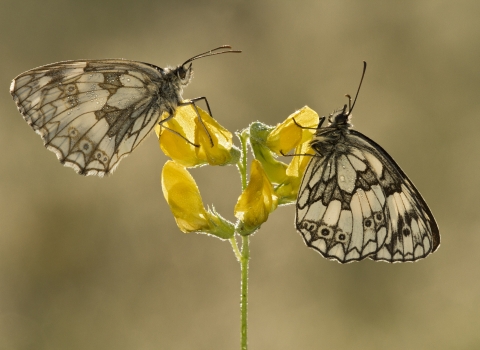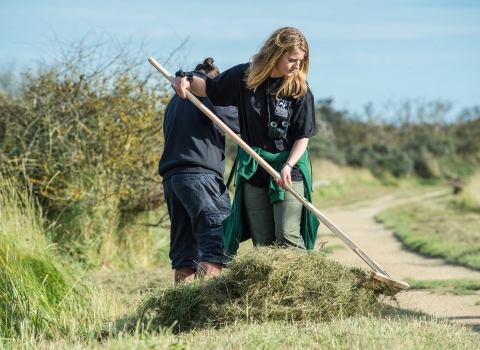Get involved
There are a number of specialist interest groups dedicated to conserving and recording Somerset’s rich wildlife and varied geology. Joining these groups is one of the best ways to get actively involved in recording and get support from fellow enthusiasts.
There is a group to suit every interest and they are involved in a range of different activities from surveying to practical conservation work. Many also provide advice to members of the public and conservation organisations, and they are an invaluable source of local expertise.
Specialist groups
Find out further information about each of the groups by clicking the arrows below.
Exmoor Natural History Society
The Exmoor Natural History Society aims to further the study and recording of the botanical and wildlife of Exmoor and to assist in its preservation.
North Somerset and Bristol Fungi Group
This group strives to promote the conservation of fungi and their threatened habitats. Membership of the group is open to all individuals who support these aims. The group meets regularly to identify and record fungi in North Somerset and spreads awareness about the importance of fungi in the environment. Their main activities are forays, which often include joint meetings with other SW Fungus Groups, and annual workshops.
Recorders of the Avalon Marshes (RoAM)
Purpose
RoAM exists to record the wildlife of the Somerset Wetlands and the wider area particularly focussing on the less obvious or rare flora and fauna. We also record relevant environmental factors such as weather conditions and water quality.
Organisation
We are an independent voluntary group which works closely with the conservation organisations based at the Avalon Marshes Centre (Natural England, Somerset Wildlife Trust, The Hawk and Owl Trust, and RSPB). We also work with other landowners with an interest in conservation in the area. Our records provide essential management information to these organisations and help to ensure that the species we study will continue to thrive in this special landscape.
Reptile and Amphibian Group for Somerset
The Reptile and Amphibian Group for Somerset (RAGS) is a not-for-profit organisation dedicated to promoting the interests of wild, native reptiles and amphibians across Somerset and forms part of the national ARG-UK network.
Working closely with all other relevant conservation organisations, RAGS aims to raise awareness of the county’s snakes, lizards, newts, frogs and toads, providing expertise for a variety of advisory and educational purposes, while keeping enthusiasts connected with one another.
There is no membership fee and everyone is welcome to join.
Somerset Archaeological and Natural History Society
The society exists to promote the study of archaeology, natural history, local history and historic buildings with particular reference to the historic county of Somerset, and is an important point of contact for anyone with an interest in understanding and protecting the heritage of Somerset.
Somerset Badger Group
The Somerset Badger Group is committed to conserving, protecting and promoting badgers, their habitats and resting places, along with other native wildlife, by educating the wider public.
Somerset Bat Group
Somerset has 16 out of the 17 species of British bats. Some of these species are common in Somerset, whilst some are endangered. The Bat Group is actively engaged in various activities to help preserve these fascinating creatures.
They run events and surveys, including bat walks in the summer. They also give talks to local groups, install and check bat boxes, take part in many national bat monitoring and local surveys. During the winter they hold workshops and courses in Bat Care, Analysing Bat Sound, and Bat Identification.
Somerset Botany Group
What does the group do?
We carry out surveys of trees, shrubs, wild flowers, grasses and ferns (collectively known as vascular plants) for Somerset Wildlife Trust and other landowners interested in nature conservation.
Our survey results are provided to landowners or managers and:
- The Botanical Society of Britain and Ireland (BSBI)
- Somerset Environmental Record Centre (SERC).
Why do we do it?
Because it is fun and useful. We see some the best habitats in the county and make a real contribution to their management. Vascular plant diversity is a key indicator of overall habitat condition, given the dependence of many other species, such as butterflies, on plants and their ecological associations.
How do I get involved?
New members are very welcome, whatever your abilities. Existing members will be more than happy to help you develop your identification skills.
We meet every Tuesday from April to September, usually on the Mendips, Levels or Poldens and occasionally further afield in the county.
We are also happy to receive requests to carry out surveys from local groups and reserve managers. Contact: Chris Billinghurst Tel: 01761 221579 or email Val Graham at somersetbotanygroup@gmail.com
Somerset Butterfly Group
The group takes part in guided walks, new members’ days and training days that run through the summer, while in winter they have an AGM, which attracts some top-notch speakers and offers a remarkable abundance and quality of cakes, and the New Year social Get-together.
The main task is Transect Walking which gives them information on butterfly population trends that guides conservation priorities and also feeds into research on climate change and global warming. The group also keeps an eye on grazing animals, checks the abundance of caterpillar food plants and carries out scrub-bashing on the four butterfly reserves in the Branch area, and other local nature reserves.
The group loves to enthuse people about butterflies and moths.
Somerset Geology Group
We are a network, of both professionals and amateurs, with an interest in geological conservation and associated activity in Somerset.
Somerset Geology Group (SGG) works in partnership with Somerset Environmental Records Centre and Somerset Wildlife Trust to encourage appreciation, conservation and promotion of the geology of Somerset. We encourage the appreciation, conservation and promotion of local/regional geological sites for education and public benefit.
Our main priority at present is working with SERC to review Somerset’s 230 Local Geological Sites (LGS). We also advise on planning and development affecting LGS and assist with enquiries about their conservation and interpretation.
Somerset Hedge Group
Somerset has a rich network of hedgerows and field boundaries ranging from the upland beech hedges of Exmoor, the Blackdown and Quantock Hills in the west, to the lowland ancient species-rich hedges throughout central Somerset, rising again to the stone walls and hedges of the Mendip Hills.
The aims of the group are
- To promote good practice in hedge management
- To raise awareness and appreciation of the value of hedges to farming and non-farming communities
- To increase the conservation of the hedge network across the county
The Somerset Hedge Group promotes responsible hedge management through demonstrations; competitions; advice on training courses, management and grant aid; publicity and other initiatives.
Somerset Mammal Group
Somerset Mammal Group promotes the study and monitoring of wild mammals across the county. The group also acts as an informal network to help mammal recorders keep in touch and coordinate recording efforts throughout Somerset. There are three other groups based in Somerset who specialise in mammals, covering bats, badgers and otters. Our primary focus is the recording of the other native and non-native mammal species in the county.
Somerset Moth Group
The Somerset Moth Group aims are to record and study the moths of this area and to promote interest in these fascinating creatures. The group caters for all levels of expertise, from the beginner to the expert.
Somerset Ornithological Society
The Somerset Ornithological Society aims to promote interest in the birdlife of the county, further the monitoring of birds, and to assist in their preservation. It aims to appeal to all that have an interest in the birds of Somerset, whether their birding is social or scientific, as experts or as novices, young and old.
Bird records, through sightings, ringing reports and studies, are collected and published annually by the Society in Somerset Birds. When they are allowed to resume, regular field meetings are organised and run for the benefit of our membership along with regular on-line talks. The field walks give excellent opportunities for members and guests alike to meet people with a common interest. An on-line biannual newsletter, The Bittern is also available to our members.
Somerset Otter Group
The Somerset Otter Group is a loose association of active enthusiasts. They express their appreciation of these wonderful animals by undertaking practical work which will assist in their wellbeing and in promoting awareness of their needs. The group has recorded and studied otters for over twenty years, charting their remarkable come-back since the 1980s.
The group’s survey work is vital for monitoring the population in Somerset, records are shared with the Somerset Environmental Records Centre, (SERC). The group also regularly engages with outside researchers and works with other organisations.
Somerset Rare Plants Group
The group aims to continue the long tradition of recording in Somerset and to encourage all botanists from beginners to experts to do the same. They help contribute to an understanding of plant distribution and conservation, recording all plants growing wild in Somerset, not just rarities. The mapping of plant distributions is a key function of the group
They arrange field meetings in the summer and a few indoor winter ones to plan and coordinate recording.
Wessex Bryology Group
This is an informal group for anyone interested in bryophytes (a group of plants that include mosses, liverworts and hornworts) in Somerset, Wiltshire, Dorset and Hampshire. Beginners are always most welcome.
They hold regular meetings, usually once a month, from October to May each year. Each season they aim to include meetings across the area and in as wide a range of habitats as possible. This area has some superb habitats for bryophytes, from the heaths, mires and woods of the New Forest to the hills of Exmoor and the Mendips.
Mosses and liverworts may be tiny plants, but with the help of a hand lens you can quickly discover their surprisingly beautiful and intricate world. Because many of these plants have very specific habitat requirements they can tell us a great deal about the places they inhabit, from ancient woodlands to newly colonised quarry workings. Learning about their natural history and how to identify them can be great fun. Come along and give it a go.
Other ways to get involved
Here are some other ways you can support us and get involved.


